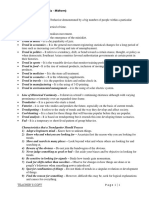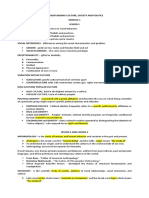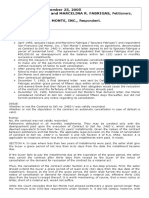100%(1)100% found this document useful (1 vote)
2K viewsNon State Institution
Non State Institution
Uploaded by
Rico Emaximus LausaThe document discusses the external debts of countries like the Philippines and where they get huge loans from. It explains that non-state institutions like the World Bank and IMF provide monetary loans to different states. Other non-state institutions that link nations together include international organizations like the UN and its specialized agencies focused on development, education, culture, and humanitarian aid such as UNESCO, UNDP, and UNICEF. Membership in these institutions helps states access loans and support on issues confronting humanity.
Copyright:
© All Rights Reserved
Available Formats
Download as PPT, PDF, TXT or read online from Scribd
Non State Institution
Non State Institution
Uploaded by
Rico Emaximus Lausa100%(1)100% found this document useful (1 vote)
2K views11 pagesThe document discusses the external debts of countries like the Philippines and where they get huge loans from. It explains that non-state institutions like the World Bank and IMF provide monetary loans to different states. Other non-state institutions that link nations together include international organizations like the UN and its specialized agencies focused on development, education, culture, and humanitarian aid such as UNESCO, UNDP, and UNICEF. Membership in these institutions helps states access loans and support on issues confronting humanity.
Original Description:
uuuiui
Copyright
© © All Rights Reserved
Available Formats
PPT, PDF, TXT or read online from Scribd
Share this document
Did you find this document useful?
Is this content inappropriate?
The document discusses the external debts of countries like the Philippines and where they get huge loans from. It explains that non-state institutions like the World Bank and IMF provide monetary loans to different states. Other non-state institutions that link nations together include international organizations like the UN and its specialized agencies focused on development, education, culture, and humanitarian aid such as UNESCO, UNDP, and UNICEF. Membership in these institutions helps states access loans and support on issues confronting humanity.
Copyright:
© All Rights Reserved
Available Formats
Download as PPT, PDF, TXT or read online from Scribd
Download as ppt, pdf, or txt
100%(1)100% found this document useful (1 vote)
2K views11 pagesNon State Institution
Non State Institution
Uploaded by
Rico Emaximus LausaThe document discusses the external debts of countries like the Philippines and where they get huge loans from. It explains that non-state institutions like the World Bank and IMF provide monetary loans to different states. Other non-state institutions that link nations together include international organizations like the UN and its specialized agencies focused on development, education, culture, and humanitarian aid such as UNESCO, UNDP, and UNICEF. Membership in these institutions helps states access loans and support on issues confronting humanity.
Copyright:
© All Rights Reserved
Available Formats
Download as PPT, PDF, TXT or read online from Scribd
Download as ppt, pdf, or txt
You are on page 1of 11
Mr. Karl Irvin M.
Baguio, RN, LPT
All states in the world have debts. These
debts may be classified into external or
public. Philippines is one debtor.
In 2013, the external debt of the Philippines
dropped from more or less USD 70 billion to
USD 67 billion. However, In 2014 up to early
2016, the countrys external debt once again
rose and even reached almost USD 78 billion
(World Bank, 2013;2016).
The question is, where did the Philippines get
all that debt? Who lends to the states, not just
to the Philippines alone, that huge amount of
money?
Since there are a large number of states in
the world, some force/s are needed to link
these states together. These institutions
participate in international relations without
needing to belong to an established
institution or state. These entities are called
non-state institutions.
The World Bank and the International Monetary
Fund, which provide the different sates monetary
loans, are example of non-state institutions.
Aside from banks, multinational corporations,
and trade unions, there are other groups of non-
state institutions that play key roles in societal
formation. They are the international and
transitional organizations.
International organizations are institutions that
aim to unite different states toward a common
good.
Transitional organization Institutions that
transcends boundaries and states to bring
together people and groups of different culture
for a specific goal.
Perhaps one of the most influential groups of
non-state institutions is the development
agencies. These are organizations which
provide development assistance between
national and international institutions.
Usually, these are the links that bind different
states together.
In 1945, the international organizations United
Nations (UN) was established to rebuild peace
after WWII. The war brought forth the birth of
non state institutions that link nations together.
Currently UN composed of 193 member states,
the UN takes action on issues confronting
humanity, such as peace and security, climate
change, sustainable development, human rights,
disarmament, terrorism, humanitarian and health
emergencies, gender equality, governance, food
production and more. The Philippines is one of
the first 55 states to become ,a member of the
organization in 1945.
Through General Assembly, a forum or dialog
among the members of the state, the UN gives its
members the freedom to express their concerns
and view regarding all sorts of issues that affect
them.
The UN is the primary common ground and
governing body of most sovereign states in the
world, and is comprised of more than 40
specialized agencies and programmes. The most
powerful non state institutions in the world
exist under or with the help of its command.
Programmes are financed through voluntary
distributions. Specialized agencies run
independently, funded by both voluntary and
assessed contributions. Development agencies
under UN.
The UNESCO is a specialized agency of the UN for the
purpose of promoting peace and security through
international partnership in education, science, culture so
that there will be a world with justice, rule of law, human
rights among others.
The UNESCO firmly believes that peace must be
established on the basis of humanitys moral and
intellectual solidarity.
Five major programs of UNESCO :
Education
Natural sciences
Social and human sciences
Culture
Communications and information
The UNDP is the United Nations development
agency that aims to eradicate poverty and to
reduce inequalities and social exclusion in the
developing countries.
UNDP focused on helping countries build and
share effective solutions in three areas:
Sustainable development
Democratic governance
Climate and disaster resilience
THE UNICEF is an intergovernmental
organization that provides humanitarian and
developmental assistance and support to
young people in developing countries. It was
founded December 11, 1946 by the UN
General Assembly to provide emergency
needs like food and healthcare to the children
who were drastically affected by WWII.
What is the significance of WB and IMF to the
different states of the world? Do you think a
state can survive without joining the said
institutions?
You might also like
- Certification of EnrollmentDocument2 pagesCertification of EnrollmentRico Emaximus LausaNo ratings yet
- Iron Triangles Notes & ActivityDocument3 pagesIron Triangles Notes & ActivityLoren OsteenNo ratings yet
- History of The Modern World Since 1815Document11 pagesHistory of The Modern World Since 1815MUSYOKA KITUKUNo ratings yet
- PPG Q1 M7 Shianne-Dancee C.-Evanz - REVISED FINALDocument17 pagesPPG Q1 M7 Shianne-Dancee C.-Evanz - REVISED FINALShianne Dancee CorpuzNo ratings yet
- DemocracyDocument24 pagesDemocracyjonna martinez100% (2)
- SLA Research Nourishing Language Teaching Practice.Document7 pagesSLA Research Nourishing Language Teaching Practice.SaSa Oviedo50% (4)
- Nara t733 r9 Guide 87Document143 pagesNara t733 r9 Guide 87Nikos SakellariouNo ratings yet
- Human Biocultural and Social EvolutionDocument19 pagesHuman Biocultural and Social EvolutionJoan Gongona100% (1)
- Baptism 2. Catholicism GovernmentDocument3 pagesBaptism 2. Catholicism GovernmentGail Valdez100% (1)
- Lesson - Social InstitutionDocument5 pagesLesson - Social Institutiondambb hoomannNo ratings yet
- Non State InstitutionDocument18 pagesNon State InstitutionJethro Vicenta Ramirez100% (1)
- State Non State InstitutionDocument29 pagesState Non State Institutionpim pimNo ratings yet
- Admshs Ucsp q2 Module 1Document29 pagesAdmshs Ucsp q2 Module 1ideza magpantayNo ratings yet
- Economic Institutions: Danilo F. Maribao Paliparan Iii Senior High School Dasmarinas City, CaviteDocument20 pagesEconomic Institutions: Danilo F. Maribao Paliparan Iii Senior High School Dasmarinas City, CaviteLowel DalisayNo ratings yet
- STATE or NON-STATE INSTITUTIONSDocument1 pageSTATE or NON-STATE INSTITUTIONSFeby Margaret AngNo ratings yet
- WRITTEN WORK 1&B, MontederamosDocument3 pagesWRITTEN WORK 1&B, MontederamosMa. Mavel MontederamosNo ratings yet
- Schools Division of Parañaque City Humanities and Social Sciences Understanding Culture, Society and Politics Second QuarterDocument7 pagesSchools Division of Parañaque City Humanities and Social Sciences Understanding Culture, Society and Politics Second QuarterAlyssa SolidumNo ratings yet
- Trends M5Document26 pagesTrends M5BUNTA, NASRAIDANo ratings yet
- Week 1Document14 pagesWeek 1liz ivy sarratoNo ratings yet
- Ucsp Las Week4Document11 pagesUcsp Las Week4Anna Theresa IgnacioNo ratings yet
- Module 3 Global NetworksDocument62 pagesModule 3 Global Networks-------100% (2)
- Ucsp11 q2 Mod10 Newchallenges v5 No QUARTER EXAM INCLUDEDDocument19 pagesUcsp11 q2 Mod10 Newchallenges v5 No QUARTER EXAM INCLUDEDRochelle Marie100% (1)
- A Position Paper On KDocument30 pagesA Position Paper On KInsight BossNo ratings yet
- UCSPDocument6 pagesUCSPManuelluis MaltoNo ratings yet
- EAPPDocument1 pageEAPPAlly OcbianNo ratings yet
- Ucsp-Learning-Module Quarter 1 Week 1Document24 pagesUcsp-Learning-Module Quarter 1 Week 1Tabaaa YtNo ratings yet
- Leader, Parties, Functions, Political: (Applying Classroom Management For Positive Learning Environment)Document7 pagesLeader, Parties, Functions, Political: (Applying Classroom Management For Positive Learning Environment)Nokie TunayNo ratings yet
- Social DifferencesDocument23 pagesSocial DifferencesJelly BaldonNo ratings yet
- Politics and Governance 5Document21 pagesPolitics and Governance 5Cyndy BautistaNo ratings yet
- State and Non-State Institutions - HarbiiDocument19 pagesState and Non-State Institutions - HarbiiCarlo Jay SalesNo ratings yet
- Module 7 Volnerabilities of Different Elements Exposed To HazardsDocument9 pagesModule 7 Volnerabilities of Different Elements Exposed To HazardsJinky AydallaNo ratings yet
- UCSP 2.1 Political OrganizationDocument5 pagesUCSP 2.1 Political OrganizationRay Faustino100% (1)
- Understanding Culture, Society and Politics: Quarter 2-Week 1 Forms and Functions of State and Non-State InstitutionsDocument21 pagesUnderstanding Culture, Society and Politics: Quarter 2-Week 1 Forms and Functions of State and Non-State InstitutionsJanna GunioNo ratings yet
- Complete Module in Understanding Culture Society and PoliticsDocument123 pagesComplete Module in Understanding Culture Society and PoliticsFahad AbdullahNo ratings yet
- Handout 1 UCSP 2019Document9 pagesHandout 1 UCSP 2019Timothy Marc PerezNo ratings yet
- UCSP 1 F-DomeDocument20 pagesUCSP 1 F-DomeAl Cheeno Anonuevo100% (1)
- Ppg-Module 7, Week 10Document10 pagesPpg-Module 7, Week 10jerry100% (1)
- TRENDS 12 HUMSS 1st Quiz MidtermDocument1 pageTRENDS 12 HUMSS 1st Quiz MidtermAilla EstrelladoNo ratings yet
- Philippine Politics and Governance (PPG) : Basic Education DepartmentDocument16 pagesPhilippine Politics and Governance (PPG) : Basic Education DepartmentJanna Marie Abol Raupan0% (1)
- Understanding Culture, Society, and Politics / Pre-First QuarterDocument5 pagesUnderstanding Culture, Society, and Politics / Pre-First QuarterKim Kathleen ArizaNo ratings yet
- Ucsp Quizzes 2019 2020Document5 pagesUcsp Quizzes 2019 2020Dhia Hermoso Guzado100% (1)
- Position Paper in FederalismDocument2 pagesPosition Paper in FederalismCecile UmaliNo ratings yet
- I. Lesson Lesson 1: Exploring Groups Within Society Specific ObjectivesDocument14 pagesI. Lesson Lesson 1: Exploring Groups Within Society Specific ObjectivesAni Vie MaceroNo ratings yet
- PPG12 Q1 Module-2 IdeologiesDocument9 pagesPPG12 Q1 Module-2 Ideologieskim kateNo ratings yet
- PPGDocument23 pagesPPGMain PageNo ratings yet
- Ucsp M1 6 ReviewerDocument9 pagesUcsp M1 6 ReviewerWayne Kendrick Marañon NeriNo ratings yet
- PPG Reviewer For ShsDocument5 pagesPPG Reviewer For ShsGoldwin RamirezNo ratings yet
- Blood of A Mole PPT 21stLIt 1Document15 pagesBlood of A Mole PPT 21stLIt 1Nikko BrionesNo ratings yet
- Understanding Culture, Society, and Politics: Social DynamicsDocument36 pagesUnderstanding Culture, Society, and Politics: Social DynamicsJames AlicanteNo ratings yet
- UCSP Module 2Document28 pagesUCSP Module 2Clarissa CachoNo ratings yet
- UCSP Official Modules For FINALS Doc1Document38 pagesUCSP Official Modules For FINALS Doc1Aron CabreraNo ratings yet
- How Dependent Are We On TechnologyDocument1 pageHow Dependent Are We On TechnologyRandy EdradaNo ratings yet
- Division of Literature/2. Elements in Understanding Literary MasterpieceDocument4 pagesDivision of Literature/2. Elements in Understanding Literary MasterpieceJohn Renzo Baldos SabadoNo ratings yet
- Human Cultural Variation Social Differences Social Change and Political IdentitiesDocument28 pagesHuman Cultural Variation Social Differences Social Change and Political Identitiesjohnmark100% (1)
- Module 8 Ucsp EducationDocument4 pagesModule 8 Ucsp EducationAnatta AttanaNo ratings yet
- Social Stratification and Rights: Module 8 - UcspDocument4 pagesSocial Stratification and Rights: Module 8 - Ucspkimberson alacyangNo ratings yet
- Philosophy of Human PersonDocument10 pagesPhilosophy of Human PersonInstagram PHNo ratings yet
- UCSP TOPIC 22 Economic InstitutionsDocument47 pagesUCSP TOPIC 22 Economic InstitutionsLiza EmmanuelleNo ratings yet
- Difference Between State and NationDocument10 pagesDifference Between State and NationJoefaithNo ratings yet
- Zamboanga Sibugay: For LearnersDocument25 pagesZamboanga Sibugay: For LearnersRymark FlorinNo ratings yet
- M10 Government Programs and Initiatives in Addressing Social InequalitiesDocument22 pagesM10 Government Programs and Initiatives in Addressing Social InequalitiesKelsey Gaile MaghanoyNo ratings yet
- Cosmophilia (Love of Other Living Beings) - Perhaps We Could Consider Him As AnDocument4 pagesCosmophilia (Love of Other Living Beings) - Perhaps We Could Consider Him As AnBalnk DhprNo ratings yet
- UCSPDocument3 pagesUCSPkayecee manuel50% (2)
- Ge 3.contemporary World.m2t4Document6 pagesGe 3.contemporary World.m2t4Tian XianNo ratings yet
- Grade 4Document4 pagesGrade 4Rico Emaximus LausaNo ratings yet
- Grades For 1st Sem AllDocument80 pagesGrades For 1st Sem AllRico Emaximus Lausa0% (1)
- Resume - Nathaniel IgnacioDocument3 pagesResume - Nathaniel IgnacioRico Emaximus LausaNo ratings yet
- Learning Activity Sheet: General Chemistry 2 - W - 7Document3 pagesLearning Activity Sheet: General Chemistry 2 - W - 7Rico Emaximus LausaNo ratings yet
- The Game of Words: UnintelligentDocument6 pagesThe Game of Words: UnintelligentRico Emaximus LausaNo ratings yet
- Thelen-Institutional ChangeDocument25 pagesThelen-Institutional ChangeOSMAN FEDAINo ratings yet
- Political Economy - by CSD in SrilankaDocument35 pagesPolitical Economy - by CSD in SrilankaSampath SamarakoonNo ratings yet
- Famous INTJsDocument4 pagesFamous INTJsElza PaivaNo ratings yet
- CIB M1 Ch1PPTsDocument26 pagesCIB M1 Ch1PPTsNathaniel McGowanNo ratings yet
- Schedule of Events For The 1988 Soviet-American Peace WalkDocument27 pagesSchedule of Events For The 1988 Soviet-American Peace WalkOur MoveNo ratings yet
- Williams Broadcasting 13Document3 pagesWilliams Broadcasting 13Ethan GatesNo ratings yet
- Reveiw of Talinn Grigor's Building Iran: Modernism, Architecture, and National Heritage Under The Pahlavi Monarchs (2009)Document2 pagesReveiw of Talinn Grigor's Building Iran: Modernism, Architecture, and National Heritage Under The Pahlavi Monarchs (2009)Negar MottahedehNo ratings yet
- Scheduled Castes Sub-Plan (SCSP), Andhra PradeshDocument10 pagesScheduled Castes Sub-Plan (SCSP), Andhra PradeshSimha CharyNo ratings yet
- Ra 8042 - RCG NotesDocument1 pageRa 8042 - RCG NotesroigtcNo ratings yet
- May 30 2014Document48 pagesMay 30 2014fijitimescanadaNo ratings yet
- Week 2 Classical Political Theory and Modern Political TheoryDocument19 pagesWeek 2 Classical Political Theory and Modern Political TheoryHazel GasconNo ratings yet
- Ngok Dinka Chiefdoms' Letter To AUPSCDocument4 pagesNgok Dinka Chiefdoms' Letter To AUPSCAbyeiReferendum2013No ratings yet
- PPG Lesson 2Document21 pagesPPG Lesson 2Dave SawiNo ratings yet
- Is Global Solidarity PossibleDocument4 pagesIs Global Solidarity PossibleNeil Joseph Alcala75% (4)
- A Typology of Definition of DiversityDocument1 pageA Typology of Definition of DiversityTrang Hong TrinhNo ratings yet
- Appointment of Judges - The Judicial Scenario inDocument38 pagesAppointment of Judges - The Judicial Scenario inAvnish Maurya0% (1)
- Decolonizing Social Work - Beth FinnDocument8 pagesDecolonizing Social Work - Beth Finnapi-507651135No ratings yet
- Argentina Today 1976Document13 pagesArgentina Today 1976Elizabeth ReetzNo ratings yet
- TNPSC Group 1,2,4,8 VAO Preparation 1Document5 pagesTNPSC Group 1,2,4,8 VAO Preparation 1SakthiNo ratings yet
- CD 3 27 Quintanar Vs Coca Cola Bottlers Philippines Inc G.R. No 210565 June 28 2016Document1 pageCD 3 27 Quintanar Vs Coca Cola Bottlers Philippines Inc G.R. No 210565 June 28 2016Mae BecherNo ratings yet
- Bangabandhu's Killer Majed HangedDocument4 pagesBangabandhu's Killer Majed HangedjonakdeyNo ratings yet
- Africa Unit Summativecommon AssessmentDocument6 pagesAfrica Unit Summativecommon AssessmentSarahNo ratings yet
- Gender and Music Gender Inequality and The Representation of Women in The Music IndustryDocument19 pagesGender and Music Gender Inequality and The Representation of Women in The Music IndustryFADWA TADISTNo ratings yet
- The Structure of Globalization: Contemporary Global GovernanceDocument15 pagesThe Structure of Globalization: Contemporary Global GovernanceMarissa AsimNo ratings yet
- Maceda Law CaseDocument2 pagesMaceda Law CaseJohn Rhil RamosNo ratings yet
- Revolt of 1857Document23 pagesRevolt of 1857Arun k SapkalNo ratings yet































































































